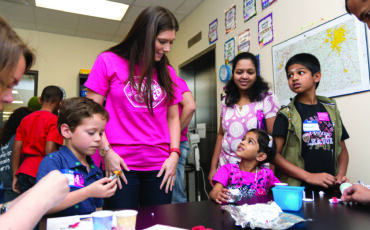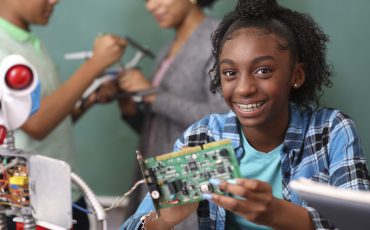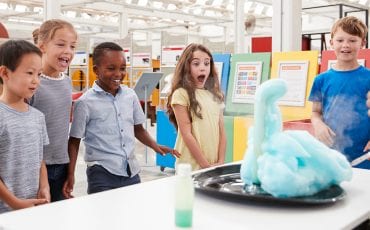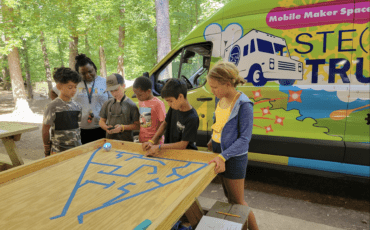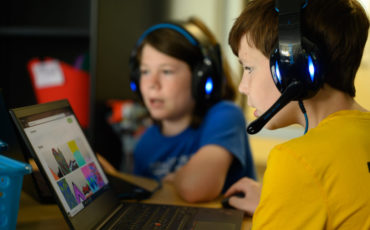STEAM Products Your Kid Will Love

SciGirls
Encourage STEAM (science, technology, engineering, art and math) learning with these exciting and educational products, books and programs.
Travel back in time to the age of dinosaurs with “Tiny Dino Worlds: Create Your Own Prehistoric Habitats” by Christine Bayles Kortsch. With 26 different projects, kids will learn more about science and history with hands-on activities, including building terrariums, erupting volcanoes and more. Informational pages and sidebars help explain concepts in a kid-friendly way.

Make learning fun with Adventerra Games’ PowerHaus. You and your friends live in an old house that leaks heat and wastes a lot of energy. Make your house more efficient without spending all your money on energy. At the end of the game, the winner is the one who has saved the most energy and money. Players discover home energy technologies and reinforce mathematical logic and scientific learning. Requires 3-4 players. For ages 7 and older.
Check out “SciGirls,” an Emmy Award-winning PBS television series that works to change the way girls see STEM. The show’s website has short videos and full episodes, as well as videos in Spanish. Games reinforce educational concepts. Practice coding with Code Quest, where you’ll code Subby the robot to move across the aquarium. Design a robot that can function underwater with Aquabot. Find all the animals and learn about their cool characteristics with Creature Features. Play with other people from around the globe with Dream Team.

Snackable Science Experiments
Learn scientific concepts and ideas in a delicious new way with “Snackable Science Experiments: 60 Edible Tests to Try and Taste” by Emma Vanstone. The cookbook is broken down into seven sections: Investigate, Create, Build, Explore, Discover, Imagine and Invent, with recipes and experiments such as Color-Changing Paper, Density Ice Lollies, Layers-of-the-Earth Fudge and more. Each recipe includes more fun ways to explore science and learning points. For ages 6-11.
Toys can be fun and educational, helping kids learn the STEAM of concepts while they’re playing. She can pretend she’s a chemist making and testing different cosmetic products with Ooze Labs: Soap & Bath Bomb Lab. Build his own pet hedgehog that reacts to different sounds with My Robotic Pet – Tumbling Hedgehog. Add motors, lights and switches to structures to bring light and motion to her creations with Power Blox Light N’ Flight. Scribble Scrubbie Peculiar Pets Playset comes with a colorable dragon, unicorn, narwhal and yeti for cute creatures he can wash and re-color again and again. ThinkFun’s Math Dice Jr. introduces or reinforces early math skills by using equations to hit the target number to win the game.
These books offer ideas for experiments, explain concepts, discuss notable figures and more. “The Dad Lab: 50 Awesome Science Projects for Parents and Kids” has creative projects to teach kids STEM basics at home. “How Technology Works: The Facts Visually Explained” discusses the machinery that keeps the modern world going, from simple objects to the latest in the information age. “100 Easy STEAM Activities: Awesome Hands-On Projects for Aspiring Artists and Engineers” offers science experiments, delicious snacks, art projects and more. Learn more about notable artists and the artistic mediums they used with “Women in Art: 50 Fearless Creatives Who Inspired the World.” “I’m Trying to Love Math” encourages your child to overcome her fear of math and think about this subject differently.
Online resources can also help your child become more comfortable with STEAM. Check out Tumble, an entertaining podcast for kids that explains scientific discoveries with the help of scientists, exploring topics like space, dinosaurs, weather and more. Try online coding problems: code.org, codeacademy.com, kodable.com, lightbot.com, scratch.mit.edu or tynker.com, and encourage your daughter to try coding with girlswhocode.com. Design Squad Global has videos, design challenges and building activities, and your child can design wind turbines, farms, delivery methods and cities with games that help “Fidgits.” For a 360-degree look at famous artworks and sites, explorations in color and more, check out artsandculture.google.com. Kids can learn addition, subtraction, multiplication, division and fractions with cute games and challenge themselves to brain teasers at coolmath4kids.com.


